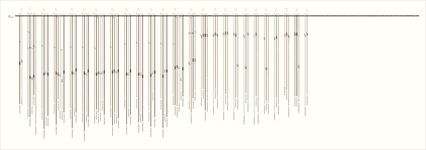| Statistics: |
Original Name: AS088/N6
Original Author: Marcia & Robert Ascher
Museum: Museum für Völkerkunde, Munich, Germany
Museum Number: G3297
Provenance: Unknown
Region: Huacho
|
# of Cords: 95 (87p 8s)
# of Unique Cord Colors: 6
Benford Match: 0.8576
# Ascher Sums (pps, ips, cps, sps,...): 31 (9, 8, 8, 0,...)
Similar Khipu: Previous (UR171) Next (QU002)>
|
|
| Notes: |
Ascher Databook Notes:
- The Museum designates the khipu as donated by Gaffron. Huacho u. Pachacamac is the provenance.
- AS088 is also discussed by Nordeskiold (see Introduction, Table 3).
- By spacing, the khipu is separated into 25 groups. Groups 2-13 and groups 14-23 are united by values and color pattern. Group 24 is separated from group 23 by a much larger space on the main cord. Hence, the khipu can be described as in 4 parts: Part I contains 1 group of 2 pendants; Part II is groups 2-13; Part III is groups 14-23; and Part IV is groups 24-25.
- Part II consists of 12 groups of 4 pendants each. (The first group has an additional blank pendant.) For every group, the color pattern is YB: W, MB, W, MB. Subsidiaries appear only on the 2nd and 3rd pendant positions: those in the second position are YB and those in the third are W. The values on the first, second, and fourth pendants of the first group are the sums of the pendant values in the corresponding positions in the remaining 11 groups. The value on the third pendant is 14 which is 3 more than the sum of the corresponding values. The values on the subsidiaries are not included in the summations.
- Part II consists of 10 groups.
- With 2 exceptions , all the groups have 3 pendants and the color pattern W , YB , YB: W . The exceptions are: the first group has a pendant colored MB instead of YB; the second group has an additional pendant colored MB .
- The values on the first and second pendants in the first group are the sums of the pendant values in the corresponding positions in the remaining 9 groups . The value on the third pendant is 14 which is 2 less than the sum of the corresponding values . The values of the one subsidiary in the first group and the additional MB pendant in the second group are not included in the sums.
- The sum of the subsidiary values omitted from the sums in Part II are equal to the sum of the subsidiary and extra pendant value omitted from the sums in Part III. Also, in both parts, it is the 3rd pendant in the first group whose value is not the exact sum of the corresponding values. Both of them have value 14: and, in one case, it was 3 in excess of the corresponding values; in the other case, there is a deficit of 2.
|













